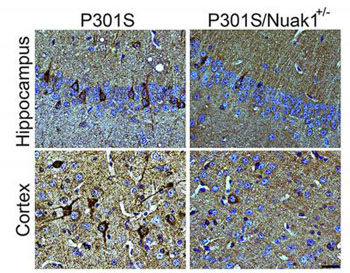Enzyme Identified Stabilizes Tau and Prevents Neurodegenerative Disease
By LabMedica International staff writers
Posted on 04 Nov 2016
Neurodegenerative disease researchers used three different model systems to screen for and identify a gene able to stabilize levels of tau protein in neurons and prevent it from accumulating in amounts capable of injuring or killing the cells.Posted on 04 Nov 2016
Investigators at Baylor College of Medicine (Houston, TX, USA) screened for a suitable tau stabilizing gene in a human-based cell culture system and in parallel with a Drosophila melanogaster (fruit fly) platform. The candidate gene was then inhibited in a mouse model. This strategy was used to screen for genes that decreased the levels of tau, whose accumulation contributes to the pathology of both Alzheimer disease (AD) and progressive supranuclear palsy (PSP).

Image: A brain section from mouse carrying the dementia-causing P301S mutation in human tau shows accumulation of tau neurofibrillary tangles (in dark brown, left). When Nuak1 levels are decreased by 50% (P301S/Nuak1+/-; right), fewer tau tangles accumulate (Photo courtesy of the Zoghbi Laboratory, Baylor College of Medicine).
The investigators reported in the October 19, 2016, issue of the journal Neuron that tau levels were regulated by the enzyme Nuak1 (NUAK family SNF1-like kinase 1, also known as AMPK-related protein kinase 5), an AMPK (5' adenosine monophosphate-activated protein kinase)-related kinase. They found that Nuak1 stabilized tau by phosphorylation specifically of the number 356 serine residue. Inhibition of Nuak1 in fruit flies suppressed neurodegeneration in tau-expressing Drosophila, and Nuak1 insufficiency rescued the phenotypes of a mouse model of tau disease.
"We found one enzyme, Nuak1, whose inhibition consistently resulted in lower levels of tau in both human cells and fruit flies," said senior author Dr. Huda Zoghbi, professor of molecular and human genetics and of pediatrics - neurology and developmental neuroscience at Baylor College of Medicine. "Then we took this result to a mouse model of Alzheimer's disease and hoped that the results would hold, and they did. Inhibiting Nuak1 improved the behavior of the mice and prevented brain degeneration. Confirming in three independent systems - human cells, the fruit fly, and the mouse - that Nuak1 inhibition results in reduced levels of tau and prevents brain abnormalities induced by tau accumulation, has convinced us that Nuak1 is a reliable potential target for drugs to prevent diseases such as Alzheimer's. The next step is to develop drugs that will inhibit Nuak1 in hope that one day would be able to lower tau levels with low toxicity in individuals at risk for dementia due to tau accumulation."
Related Links:
Baylor College of Medicine













